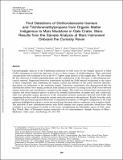First Detections of Dichlorobenzene Isomers and Trichloromethylpropane from Organic Matter Indigenous to Mars Mudstone in Gale Crater, Mars: Results from the Sample Analysis at Mars Instrument Onboard the Curiosity Rover
Author(s)
Summons, Roger E
DownloadPublished version (572.4Kb)
Publisher Policy
Publisher Policy
Article is made available in accordance with the publisher's policy and may be subject to US copyright law. Please refer to the publisher's site for terms of use.
Terms of use
Metadata
Show full item recordAbstract
Chromatographic analysis of the Cumberland mudstone in Gale crater by the Sample Analysis at Mars (SAM) instrument revealed the detection of two to three isomers of dichlorobenzene. Their individual concentrations were estimated to be in the 0.5-17 ppbw range relative to the sample mass. We also report the first detection of trichloromethylpropane and the confirmation of the detection of chlorobenzene previously reported. Supporting laboratory experiments excluded the SAM internal background as the source of those compounds, thus confirming the organic carbon and chlorine of the newly detected chlorohydrocarbons are indigenous to the mudstone sample. Laboratory experiments also demonstrated that the chlorohydrocarbons were mainly produced from chemical reactions occurring in the SAM ovens between organic molecules and oxychlorines contained in the sample. The results we obtained show that meteoritic organics and tested chemical species (a polycyclic aromatic hydrocarbon, an amino acid, and a carboxylic acid) were plausible organic precursors of the chlorinated aromatic molecules detected with SAM, thus suggesting that they could be among the organic molecules present in the mudstone. Results from this study coupled with previously reported detections of chlorinated aromatics (<300 ppbw) indigenous to the same mudstone highlight that organics can be preserved from the harsh surface conditions even at shallow depth. The detection of new chlorohydrocarbons with SAM confirms that organic molecules should have been available in an environment favorable to life forms, strengthening the habitability aspect of Gale crater.
Date issued
2020-02Department
Massachusetts Institute of Technology. Department of Earth, Atmospheric, and Planetary SciencesJournal
Astrobiology
Publisher
Mary Ann Liebert Inc
Citation
Szopa, Cyril et al. “First Detections of Dichlorobenzene Isomers and Trichloromethylpropane from Organic Matter Indigenous to Mars Mudstone in Gale Crater, Mars: Results from the Sample Analysis at Mars Instrument Onboard the Curiosity Rover.” Astrobiology 20 (2020): 292-306 © 2020 The Author(s)
Version: Final published version
ISSN
1531-1074